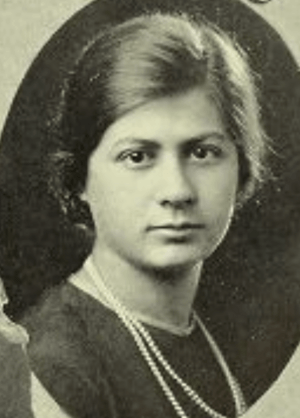Henrietta Hill Swope facts for kids
Quick facts for kids
Henrietta Hill Swope
|
|
|---|---|

Henrietta Swope, from the 1925 yearbook of Barnard College
|
|
| Born | October 26, 1902 |
| Died | November 24, 1980 (aged 78) |
| Alma mater | Barnard College (BA) Radcliffe College (MA) |
| Known for | Distances to Galaxies |
| Awards | Annie Jump Cannon Award in Astronomy (1968) |
| Scientific career | |
| Fields | Astronomy |
| Institutions | Carnegie Institution for Science |
Henrietta Hill Swope (born October 26, 1902 – died November 24, 1980) was an American astronomer. She was famous for studying special stars called variable stars. These stars change how bright they look over time. Henrietta helped figure out how to use these stars to measure huge distances in space, like how far away other galaxies are!
She focused on a type of variable star called a Cepheid. These stars are very bright. Their brightness changes in a regular pattern. By measuring this pattern, scientists can figure out how far away they are. This helped us understand the size of our own Milky Way galaxy and how far away other galaxies are.
Contents
Henrietta's Early Life
Henrietta Swope was born in St. Louis, Missouri. Her parents were Mary Hill and Gerard Swope. Her father was an engineer. He later became the president of General Electric. This meant Henrietta was financially secure throughout her life.
When she was young, Henrietta learned about astronomy. She heard talks at the Maria Mitchell Observatory. This was during family vacations in Nantucket. She even took an evening class there with her brother. She also heard a famous Harvard astronomer, Harlow Shapley, speak. Later, she would work with him.
Henrietta's Education
Henrietta went to Barnard College. She graduated in 1925 with a degree in mathematics. She only took one astronomy class during her last year.
After college, she studied for a year at the School of Social Service Administration. This was at the University of Chicago.
While working with Harlow Shapley, she continued her studies. She earned her Masters degree in Astronomy in 1928. This degree was from Radcliffe College.
Working as an Astronomer
Starting at Harvard
In 1926, Henrietta started working for Dr. Shapley at Harvard. He offered special opportunities for women to find variable stars. Henrietta joined other women, sometimes called "girls," to identify these stars. They looked for variable stars in the Milky Way galaxy. She became good friends with other astronomers like Cecilia Payne-Gaposchkin and Adelaide Ames.
Henrietta was paid by Harvard and also received money from her family. She became very skilled at figuring out how bright stars were. She did this by looking at images on photographic plates.
In 1942, Henrietta left Harvard. She went to work for MIT's staff radiation laboratory. She worked on navigation tables for a system called LORAN. This system helped ships and planes find their way. She worked there until 1947.
From 1947 to 1952, Henrietta taught astronomy. She taught at Barnard College and Connecticut College for Women. She also continued her research. She used old photographic plates from Harvard for her studies.
Discovering Distances to Galaxies
In 1952, a scientist named Walter Baade asked Henrietta to join him. He worked at the Carnegie Institution for Science. He wanted her to study variable stars in other galaxies. These stars were found using the new 200-inch Hale Telescope. This powerful telescope was at Palomar Observatory.
Henrietta was hired as Baade's research assistant. But she worked very independently. She even wrote scientific papers that included his name after he passed away. She stayed at the Carnegie Institution for the rest of her career. She officially retired in 1968.
In 1964, Henrietta and Baade published important findings. They reported on 275 Cepheid stars in the Andromeda galaxy. Henrietta had studied these stars from photographic plates. These plates were taken with the Hale Telescope. They calculated a new distance to the Andromeda galaxy. This helped scientists understand how far away other galaxies are.
Henrietta's Legacy
Henrietta Swope made a very generous gift in 1967. She donated $650,000 to the Carnegie Institution for Science. This money was used to build an observatory in the Southern Hemisphere. It helped create roads, water, and power systems for the site. It also helped build a 40-inch telescope.
This telescope was built at Carnegie's Las Campanas Observatory in Chile. It was named the Swope Telescope in her honor. The telescope started working in 1971 and is still used today! Henrietta also left most of her money to Carnegie. This was to support more research at Las Campanas and in astronomy.
Henrietta Hill Swope passed away in Pasadena, California at the age of 78.
Awards and Honors
- Annie J. Cannon Award in Astronomy in 1968
- Asteroid 2168 Swope is named after her.
- Barnard Distinguished Alumnae Award, 1975
- The Swope Telescope at the Las Campanas Observatory in Chile is named in her honor.
- Honorary PhD, 1975, University of Basel, Switzerland
- Barnard College Medal of Distinction, 1980

